- Home
- Core Offerings
- Instrumentation
Instrumentation
REACT core facility provides a range of instrumentation and services for catalysis research. All instrumentation and services are available to Northwestern students, students of outside universities, and industrial researchers. Below is a description of our standard instrumentation offerings. Some systems are amenable to minor modifications on request.
REACT's instrumentation & services rates
If you have any questions about the core’s capabilities, are interested in using the lab's equipment, or would like more details about rates, please email REACT Operations Director Selim Alayoglu at selim.alayoglu@northwestern.edu for more information.
Reactor Lab
Gas/Vapor Phase Reactions
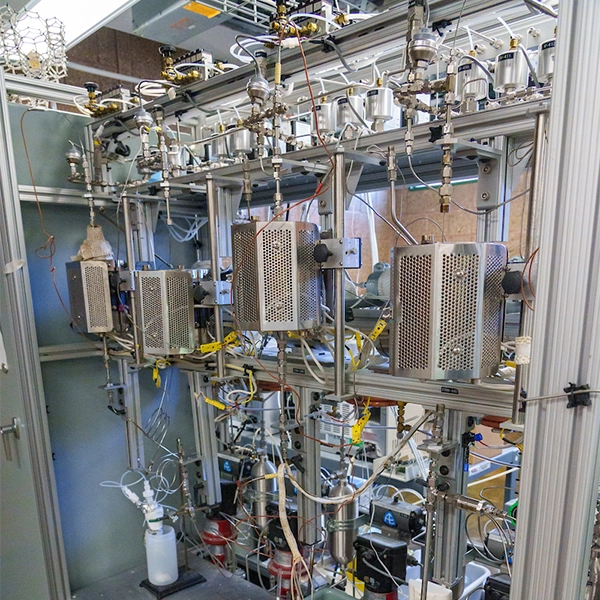 REACT houses a modified BenchCAT 4000 reactor system from Altamira Instruments. The BenchCAT consists of four, fully automated, independently operated, plug-flow reactors used for catalyst screening and kinetic studies. Each station utilizes three to five mass flow controllers, a high temperature furnace (maximum temperature of 1100°C), a temperature controlled vapor generator, gas pressure safety equipment, and is equipped with an on-stream gas chromatography system (GC) for direct measurement of reaction products. Users may customize the station to test user-defined chemistries or use standardized protocols and established chemistries to compare their materials to benchmark material data provided by REACT. The core provides inert gases for each station, reagent gases for standardized protocols, operating gases for all the GC’s, and reactor consumables. Customers are responsible for providing specialty gases and liquids. Contact REACT staff for more details and about customization options.
REACT houses a modified BenchCAT 4000 reactor system from Altamira Instruments. The BenchCAT consists of four, fully automated, independently operated, plug-flow reactors used for catalyst screening and kinetic studies. Each station utilizes three to five mass flow controllers, a high temperature furnace (maximum temperature of 1100°C), a temperature controlled vapor generator, gas pressure safety equipment, and is equipped with an on-stream gas chromatography system (GC) for direct measurement of reaction products. Users may customize the station to test user-defined chemistries or use standardized protocols and established chemistries to compare their materials to benchmark material data provided by REACT. The core provides inert gases for each station, reagent gases for standardized protocols, operating gases for all the GC’s, and reactor consumables. Customers are responsible for providing specialty gases and liquids. Contact REACT staff for more details and about customization options.
Liquid Phase/High Pressure Reactions
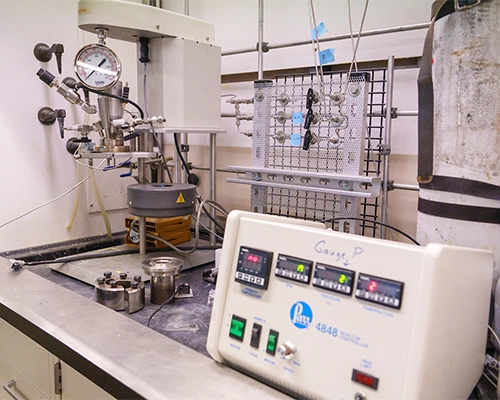 REACT houses one standardized 4590 micro bench top autoclave Parr reactor intended for high pressure, liquid phase catalyst testing. The system is rated up to 350°C and 200 bar. The reactor is accompanied by a 4848 control box that is used to control the reactor temperature, control the magnetic stirrer speed, and precisely measure the pressure. Additionally, the reactor is accompanied by a custom built, gas manifold system, which allows the introduction of three separate gases. The headspace gas can be sampled and analyzed using GC. Minor modifications to the system are possible.
REACT houses one standardized 4590 micro bench top autoclave Parr reactor intended for high pressure, liquid phase catalyst testing. The system is rated up to 350°C and 200 bar. The reactor is accompanied by a 4848 control box that is used to control the reactor temperature, control the magnetic stirrer speed, and precisely measure the pressure. Additionally, the reactor is accompanied by a custom built, gas manifold system, which allows the introduction of three separate gases. The headspace gas can be sampled and analyzed using GC. Minor modifications to the system are possible.
Liquid Phase Continuous Flow Reactor
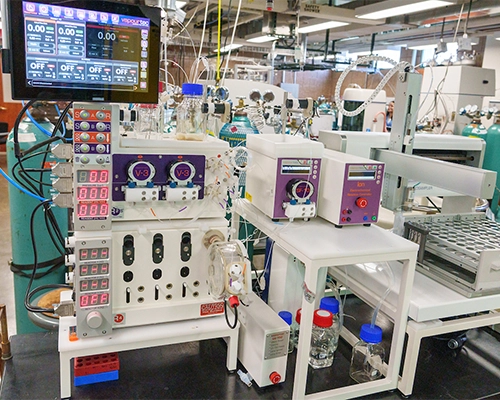 The Vapourtec flow reactor system has two peristaltic pumps for reagent delivery to the reactor module(s). Up to four reactors can be configured in the system and REACT currently has a standard coiled tube reactor, photochemical reactor, and electrochemical reactor. Vapourtec has other reactors available, and it is possible to custom build reactors. When large amounts of reactant are required, the pumps can deliver this from two bottles (up to 1000 ml). If more than two reactants are required, smaller volumes (up to 40 ml) can be delivered by the autosampler system. When very limited quantities of reactant are being used, the user can manually inject this into the sampling loop (2 ml). Large quantities of a product can be collected in a bottle. When the user is exploring the effects of reaction conditions, a liquid handler can deliver these to vials (2.0 to 40 ml). The system is relevant to researchers who need to optimize reaction conditions with minimal user intervention and for possible transition from batch processes to continuous flow methods with eventual scaleup.
The Vapourtec flow reactor system has two peristaltic pumps for reagent delivery to the reactor module(s). Up to four reactors can be configured in the system and REACT currently has a standard coiled tube reactor, photochemical reactor, and electrochemical reactor. Vapourtec has other reactors available, and it is possible to custom build reactors. When large amounts of reactant are required, the pumps can deliver this from two bottles (up to 1000 ml). If more than two reactants are required, smaller volumes (up to 40 ml) can be delivered by the autosampler system. When very limited quantities of reactant are being used, the user can manually inject this into the sampling loop (2 ml). Large quantities of a product can be collected in a bottle. When the user is exploring the effects of reaction conditions, a liquid handler can deliver these to vials (2.0 to 40 ml). The system is relevant to researchers who need to optimize reaction conditions with minimal user intervention and for possible transition from batch processes to continuous flow methods with eventual scaleup.Powder Surface Area/Pore Structure Analysis
 Micromeritics 3Flex is the state-of-the-art instrument for measuring surface area and pore characteristics of solid powders. Fully automated, this instrument measures data on three separate samples simultaneously with minimal user labor required. Furthermore, its advanced vacuum system is ultra-stable allowing enhanced resolution for low-pressure measurements (i.e. higher accuracy for low surface area materials and small pore sizes!). REACT has established protocols for measuring nitrogen, krypton, and carbon dioxide isotherms. However, there is virtually no limit to the nature of the adsorbate as user-supplied gases and vapors can be accommodated. For these measurements, a Micromeritics Iso-controller precisely controls the sample temperature between 0°C and 80°C.
Micromeritics 3Flex is the state-of-the-art instrument for measuring surface area and pore characteristics of solid powders. Fully automated, this instrument measures data on three separate samples simultaneously with minimal user labor required. Furthermore, its advanced vacuum system is ultra-stable allowing enhanced resolution for low-pressure measurements (i.e. higher accuracy for low surface area materials and small pore sizes!). REACT has established protocols for measuring nitrogen, krypton, and carbon dioxide isotherms. However, there is virtually no limit to the nature of the adsorbate as user-supplied gases and vapors can be accommodated. For these measurements, a Micromeritics Iso-controller precisely controls the sample temperature between 0°C and 80°C.
Bulk solid and powder samples can be analyzed with the Gemini VII 2390 to determine specific surface area, total pore volume, and pore size distribution. This information can be used to understand the impact of synthesis and fabrication conditions on the resulting material. The effect of surface area and porosity on materials performance can also be investigated. Applications include catalysis, energy storage, and adhesion.
Micromeritics Gemini VII 2390 Analyzer
Powder Reactivity Measurements
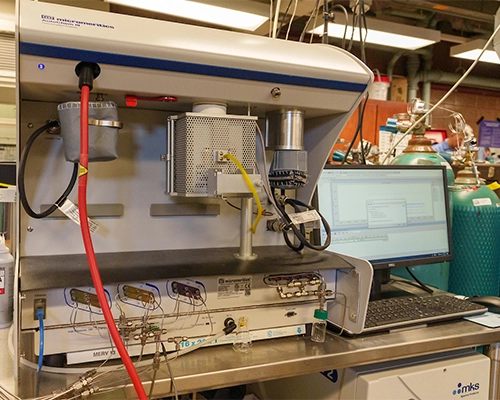 The Micromeritics AutoChem III is an updated version of the AutoChem II with improved measurement automation. The system can be used to study solid and powder material adsorption and reactivity through temperature programmed techniques (TPD, TPR, TPO, TPSR). Operating temperature is 0 °C to 1200 °.
The Micromeritics AutoChem III is an updated version of the AutoChem II with improved measurement automation. The system can be used to study solid and powder material adsorption and reactivity through temperature programmed techniques (TPD, TPR, TPO, TPSR). Operating temperature is 0 °C to 1200 °.
The Micromeritics AutoChem II HP is an automated catalyst characterization system with a thermal conductivity detector. Bulk solid and powder samples can be analyzed to yield information such as surface area, metal dispersion, oxidation/reduction capacity, surface acid/base quantification and strength, and adsorption/desorption properties. This can aid in catalyst design, synthesis, and performance evaluation. Operating temperature is 20 °C to 1100 °C, and pressure is 15-1000 psi.
Micromeritics Autochem II HP
Spectroscopy Lab
In-situ Infrared Spectroscopy
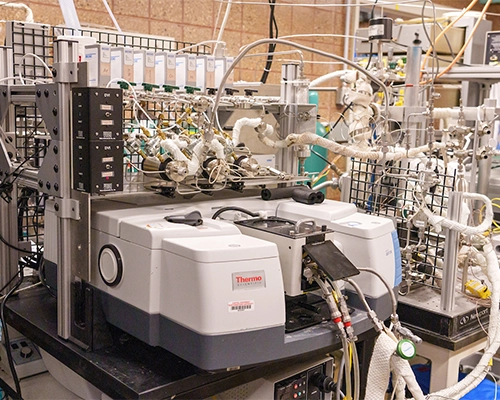 REACT houses a modular Thermo iS50 infrared spectrometer equipped with a Harrick Praying Mantis diffuse reflectance infrared Fourier Transform spectrometer (DRIFTS) attachment for analyzing solid powder surfaces under gas/vapor atmospheres and light illumination. Powder samples can be exposed to a wide variety of gases up to 550°C. The reaction chamber is also equipped with a quartz observation window, which can be utilized to shine lasers or broadband light sources. The system uses a custom-built gas manifold; various gases including Ar, H2, O2, CO, CO2, 13CO2, NH3, N2O, and D2 are available for users. A bubbler is also available for the introduction of vapors. Finally, a custom-designed, injection system has been installed for the dedicated introduction of pyridine vapor to the measurement chamber. The system is also eqquiped with a custom built gas manifold system designed for steady-state isotopic transient kinetic analysis (SSITKA) experiments. The system uses fast switching valves and a transmission, IR reaction chamber with low dead volume rated to 350°C. These features, with the use of our UGA-100, enable the accurate measurement of the dynamic bonding and desorption characteristics of reactive surface species. Additionally, this system is also used for gas-phase, breakthrough adsorption measurements and quantitative adsorption uptake measurements. Available gases: Ar, H2, O2, CO, CO2, 13CO2, NH3, N2O, and D2.
REACT houses a modular Thermo iS50 infrared spectrometer equipped with a Harrick Praying Mantis diffuse reflectance infrared Fourier Transform spectrometer (DRIFTS) attachment for analyzing solid powder surfaces under gas/vapor atmospheres and light illumination. Powder samples can be exposed to a wide variety of gases up to 550°C. The reaction chamber is also equipped with a quartz observation window, which can be utilized to shine lasers or broadband light sources. The system uses a custom-built gas manifold; various gases including Ar, H2, O2, CO, CO2, 13CO2, NH3, N2O, and D2 are available for users. A bubbler is also available for the introduction of vapors. Finally, a custom-designed, injection system has been installed for the dedicated introduction of pyridine vapor to the measurement chamber. The system is also eqquiped with a custom built gas manifold system designed for steady-state isotopic transient kinetic analysis (SSITKA) experiments. The system uses fast switching valves and a transmission, IR reaction chamber with low dead volume rated to 350°C. These features, with the use of our UGA-100, enable the accurate measurement of the dynamic bonding and desorption characteristics of reactive surface species. Additionally, this system is also used for gas-phase, breakthrough adsorption measurements and quantitative adsorption uptake measurements. Available gases: Ar, H2, O2, CO, CO2, 13CO2, NH3, N2O, and D2.In-situ UV/Vis Resonance Raman Spectroscopy
WITEC Alpha 300 RAS Confocal AFM SNOM Raman
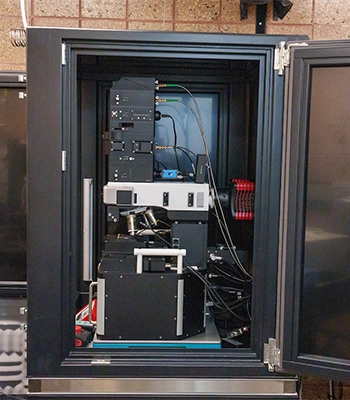 WITEC Alpha 300 RAS instrument is a correlative spectro-microscopy tool that brings Raman spectroscopy together with confocal imaging, atomic force microscopy (AFM) imaging and scanning near-field optical microscopy (SNOM) imaging. High numerical aperture (NA) objective lenses allow Raman microscopy studies at diffraction limit for sample sizes from several microns to several millimeters. The instrument is also equipped with a scanning probe microscopy (SPM) head and a piezo nanopositioning stage for correlative AFM and SNOM spectro-microscopy measurements at sub-diffraction limit for local information. Two excitation wavelengths are currently available: 532 nm (green) and 785 nm (red).
WITEC Alpha 300 RAS instrument is a correlative spectro-microscopy tool that brings Raman spectroscopy together with confocal imaging, atomic force microscopy (AFM) imaging and scanning near-field optical microscopy (SNOM) imaging. High numerical aperture (NA) objective lenses allow Raman microscopy studies at diffraction limit for sample sizes from several microns to several millimeters. The instrument is also equipped with a scanning probe microscopy (SPM) head and a piezo nanopositioning stage for correlative AFM and SNOM spectro-microscopy measurements at sub-diffraction limit for local information. Two excitation wavelengths are currently available: 532 nm (green) and 785 nm (red).